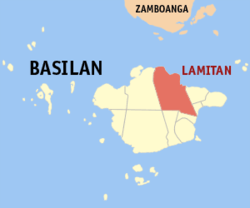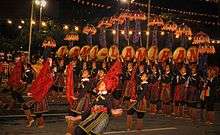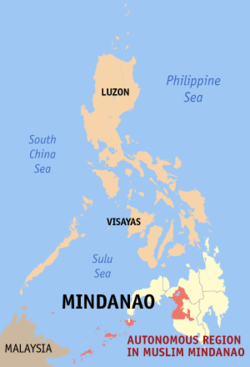Lamitan
| Lamitan | ||
|---|---|---|
| Component City | ||
| City of Lamitan | ||
 Datu Kalun (Pedro Cuevas) Shrine in Lamitan City, founder of Lamitan | ||
| ||
| Motto(s): Lamitan Kong Mahal (Lamitan, My Love) | ||
 Map of Basilan with Lamitan highlighted | ||
.svg.png) Lamitan Location within the Philippines | ||
| Coordinates: 6°39′N 122°08′E / 6.65°N 122.13°ECoordinates: 6°39′N 122°08′E / 6.65°N 122.13°E | ||
| Country |
| |
| Region | Autonomous Region in Muslim Mindanao (ARMM) | |
| Province | Basilan | |
| District | Lone District | |
| Founded | 1886 | |
| Cityhood | June 8, 2007 | |
| Barangays | 45 (see Barangays) | |
| Government [1] | ||
| • Type | Sangguniang Panlungsod | |
| • Mayor | Rosita U. Furigay | |
| • Electorate | 45,827 voters (2016) | |
| Area [2] | ||
| • Total | 354.45 km2 (136.85 sq mi) | |
| Population (2015 census)[3] | ||
| • Total | 74,782 | |
| • Density | 210/km2 (550/sq mi) | |
| Time zone | UTC+8 (PST) | |
| ZIP code | 7302 | |
| PSGC | 150702000 | |
| IDD : area code | +63 (0)62 | |
| Climate type | Tropical climate | |
| Income class | 6th city income class | |
| Revenue (₱) | 444,888,558.34 (2016) | |
| Native languages |
Chavacano Yakan Tagalog | |
| Website |
lamitancity | |
Lamitan, officially the City of Lamitan, (Tausūg: Bandar sin Lamitan; Chavacano: Ciudad de Lamitan; Yakan: Sooweedad Lamitanin), or simply known as Lamitan City, is a 6th class city in the province of Basilan, Philippines. According to the 2015 census, it has a population of 74,782 people.[3]
The city is bounded on the east by the municipality of Tuburan, on the south by Tipo-Tipo, on the west by Isabela City and on the north by Basilan Strait.
On July 2016, the Basilan provincial government broke ground for the construction of the new provincial capitol inside the defunct 4,000-hectare University of the Philippines (UP) Land Grant in Barangay Santa Clara.[4][5]
Geography
The terrain is relatively plain along the coastal areas and hilly in some areas. The urban area is 2.5 meters above sea level and gently sloping to 300 meters toward the hinterlands.
Climate
The climatic condition is the same with other areas in the entire Basilan Island. It has a "D" type of climate and rainfall is evenly distributed throughout the year.
History
During the 11th Congress (1998–2001), Congress enacted into law 33 bills converting 33 municipalities into cities. However, Congress did not act on a further 24 bills converting 24 other municipalities into cities.
During the 12th Congress (2001–2004), Congress enacted into law Republic Act No. 9009 (RA 9009), which took effect on 30 June 2001. RA 9009 amended Section 450 of the Local Government Code by increasing the annual income requirement for conversion of a municipality into a city from ₱20 million to ₱100 million. The rationale for the amendment was to restrain, in the words of Senator Aquilino Pimentel, "the mad rush" of municipalities to convert into cities solely to secure a larger share in the Internal Revenue Allotment despite the fact that they are incapable of fiscal independence.
After RA 9009 went into effect, the House of Representatives of the 12th Congress adopted Joint Resolution No. 29, which sought to exempt from the ₱100 million income requirement in RA 9009 the 24 municipalities whose cityhood bills were not approved in the 11th Congress. However, the 12th Congress ended without the Senate having approved Joint Resolution No. 29.
During the 13th Congress (2004–2007), the House of Representatives re-adopted former Joint Resolution No. 29 as Joint Resolution No. 1 and forwarded it to the Senate for approval. However, the Senate again failed to approve the Joint Resolution. Following the suggestion of Senator Aquilino Pimentel (Senate President), 16 municipalities filed, through their respective sponsors, individual cityhood bills. The 16 cityhood bills each contained a common provision exempting it from the ₱100 million income requirement of RA 9009 –
"Exemption from Republic Act No. 9009. — The City of x x x shall be exempted from the income requirement prescribed under Republic Act No. 9009."
On 22 December 2006, the House of Representatives approved the cityhood bills. The Senate also approved the cityhood bills in February 2007, except that of Naga, Cebu which was passed on 7 June 2007. These cityhood bills lapsed into law on various dates from March to July 2007 after President Gloria Macapagal-Arroyo failed to sign them.
On June 18, 2007 voters in Lamitan ratified Republic Act 9393. 26,636 voted "yes" while only 177 voted against.The point of law at issue in 2007 was whether there had been a breach of Section 10, Article X of the 1987 Constitution, which provides –
No province, city, municipality, or barangay shall be created, divided, merged, abolished or its boundary substantially altered, except in accordance with the criteria established in the local government code and subject to approval by a majority of the votes cast in a plebiscite in the political units directly affected.
– and in each case the established criteria were far from met.
In November 2008, Lamitan and 15 other cities lost their cityhood after the Supreme Court of the Philippines granted a petition filed by the League of Cities of the Philippines, and declared unconstitutional the cityhood law (RA 9393) which had allowed the town to acquire its city status.[6] The Supreme Court ruled that they did not pass the requirements for cityhood.[7][8]
On 10 December 2008, the 16 cities affected acting together filed a motion for reconsideration with the Supreme Court. More than a year later, on 22 December 2009, acting on said appeal, the Court reversed its earlier ruling as it ruled that "at the end of the day, the passage of the amendatory law" (regarding the criteria for cityhood as set by Congress) "is no different from the enactment of a law, i.e., the cityhood laws specifically exempting a particular political subdivision from the criteria earlier mentioned. Congress, in enacting the exempting law/s, effectively decreased the already codified indicators."[9] Accordingly cityhood status was restored.
But on 27 August 2010, the 16 cities lost their city status again, after the Supreme Court voted 7-6, with two justices not taking part, to reinstate the 2008 decision declaring as "unconstitutional" the Republic Acts that converted the 16 municipalities into cities. A previous law required towns aspiring to become cities to earn at least ₱100 million annually, which none of the 16 did.[10]
On 15 February 2011, the Supreme Court made another volte-face and upheld for the third time the cityhood of 16 towns in the Philippines.[11]
Finally, on 12 April 2011, the Supreme Court, in an en banc ruling delivered in Baguio City, affirmed the finality of the constitutionality of the 16 cityhood laws by resolving that:
We should not ever lose sight of the fact that the 16 cities covered by the Cityhood Laws not only had conversion bills pending during the 11th Congress, but have also complied with the requirements of the LGC prescribed prior to its amendment by R.A. No. 9009.[10] Congress undeniably gave these cities all the considerations that justice and fair play demanded. Hence, this Court should do no less by stamping its imprimatur to the clear and unmistakable legislative intent and by duly recognizing the certain collective wisdom of Congress. WHEREFORE, the Ad Cautelam Motion for Reconsideration (of the Decision dated 15 February 2011) is denied with finality.[11]
On 28 June 2011 the Supreme Court directed the Clerk of Court to issue the entry of judgment on the cityhood case of 16 municipalities.[12]
Barangays
Lamitan is politically subdivided into 45 barangays.
- Arco
- Ba-as
- Baimbing
- Balagtasan
- Balas
- Balobo
- Bato
- Boheyakan
- Buahan
- Boheibu
- Bohesapa
- Bulingan
- Cabobo
- Campo Uno
- Colonia
- Calugusan
- Kulay Bato
- Limo-ok
- Lo-ok
- Lumuton
- Luksumbang
- Malo-ong Canal
- Malo-ong San Jose
- Parangbasak
- Santa Clara
- Tandong Ahas
- Tumakid
- Ubit
- Bohebessey
- Baungos
- Danit-Puntocan
- Sabong
- Sengal
- Ulame
- Bohenange
- Boheyawas
- Bulanting
- Lebbuh
- Maganda (Poblacion)
- Malakas (Poblacion)
- Maligaya (Poblacion)
- Malinis (Poblacion)
- Matatag (Poblacion)
- Matibay (Poblacion)
- Simbangon
Demographics
| Population census of Lamitan | ||
|---|---|---|
| Year | Pop. | ±% p.a. |
| 1960 | 35,160 | — |
| 1970 | 37,423 | +0.62% |
| 1975 | 39,703 | +1.19% |
| 1980 | 45,223 | +2.64% |
| 1990 | 47,859 | +0.57% |
| 1995 | 54,433 | +2.44% |
| 2000 | 58,709 | +1.63% |
| 2007 | 82,074 | +4.73% |
| 2010 | 68,996 | −6.12% |
| 2015 | 74,782 | +1.55% |
| Source: Philippine Statistics Authority[3][13][14][15] | ||
Historical sites

Datu Kalun Shrine – Built as a tribute to a famous Yakan leader and founder of Lamitan. His descendants are the Antonio-Cuevas-Pamaran clan.
Museum of Lamitan – Showcases the color and highlights of the Lami-lamihan festival. It also serves as the information center for the development of this town.
Education
Tertiary
Lamitan is home to one (1) state college and three (3) private colleges. The Basilan State College is an extension college of the main SUC in Isabela City. The three HEIs are the Mindanao Autonomous College, the Mariam School of Nursing and Furigay Colleges, Inc. (FCI).
The Mariam School of Nursing was established in 2004 as part of its Chairwoman's educational outreach program and was named Mariam or Mother Mary - a unifying and guiding figure among the Christians and Muslims. Also offers 11 Tesda Qualifications for National Certificates.
Secondary
Lamitan City has Seven Secondary Schools: one Private Secondary School; the Claret School of Lamitan,one Laboratory School of Basilan State College and five National High Schools i.e. Lamitan National High School, Look National High School,Colony National High School,Ubit National High School and Parangbasak National High School.
Elementary
There are five districts that composed of thirty nine elementary schools namely; Lamitan East District, South District,Central District, West I District and West II District. There are four private elementary schools.
References
- ↑ "City". Quezon City, Philippines: Department of the Interior and Local Government. Retrieved 30 May 2013.
- ↑ "Province: Basilan". PSGC Interactive. Quezon City, Philippines: Philippine Statistics Authority. Retrieved 12 November 2016.
- 1 2 3 Census of Population (2015). "ARMM – Autonomous Region in Muslim Mindanao". Total Population by Province, City, Municipality and Barangay. PSA. Retrieved 20 June 2016.
- ↑ http://www.philstar.com/nation/2016/02/28/1557698/armm-put-new-basilan-capitol
- ↑ http://www.philstar.com/nation/2016/02/28/1557698/armm-put-new-basilan-capitol
- ↑ Republic Act No. 9393 (15 March 2007), Charter of the City of Lamitan
- ↑ G.R. No. 176951, First appeal; et al. (18 November 2008), Consolidated petitions for prohibition assailing the constitutionality of the subject Cityhood Laws and enjoining the Commission on Elections (COMELEC) and respondent municipalities from conducting plebiscites pursuant to the Cityhood Laws.
- ↑ Napallacan, Jhunex (2008-11-21). "Cities' demotion worries DepEd execs". Cebu Daily News. Inquirer.net. Retrieved 15 February 2015.
- ↑ G.R. No. 176951, First reversal; et al. (21 December 2009), League of Cities of the Philippines v. COMELEC
- 1 2 Republic Act No. 9009 (24 February 2001), An Act amending section 450 of Republic Act no. 7160, otherwise known as the Local Government Code of 1991, by increasing the average annual income requirement for a municipality or cluster of barangays to be converted into a component city.
- 1 2 G.R. No. 176951, Second appeal; et al. (15 February 2011), League of Cities of the Philippines v. COMELEC
- ↑ G.R. No. 176951, Final Resolution; et al. (28 June 2011), Supreme Court has directed the Clerk of Court to forthwith issue the Entry of Judgment
- ↑ Census of Population and Housing (2010). "ARMM – Autonomous Region in Muslim Mindanao". Total Population by Province, City, Municipality and Barangay. NSO. Retrieved 29 June 2016.
- ↑ Censuses of Population (1903–2007). "ARMM – Autonomous Region in Muslim Mindanao". Table 1. Population Enumerated in Various Censuses by Province/Highly Urbanized City: 1903 to 2007. NSO.
- ↑ "Province of Basilan". Municipality Population Data. Local Water Utilities Administration Research Division. Retrieved 17 December 2016.
External links
| Wikimedia Commons has media related to Lamitan. |


